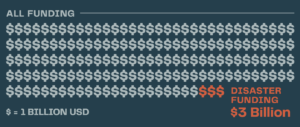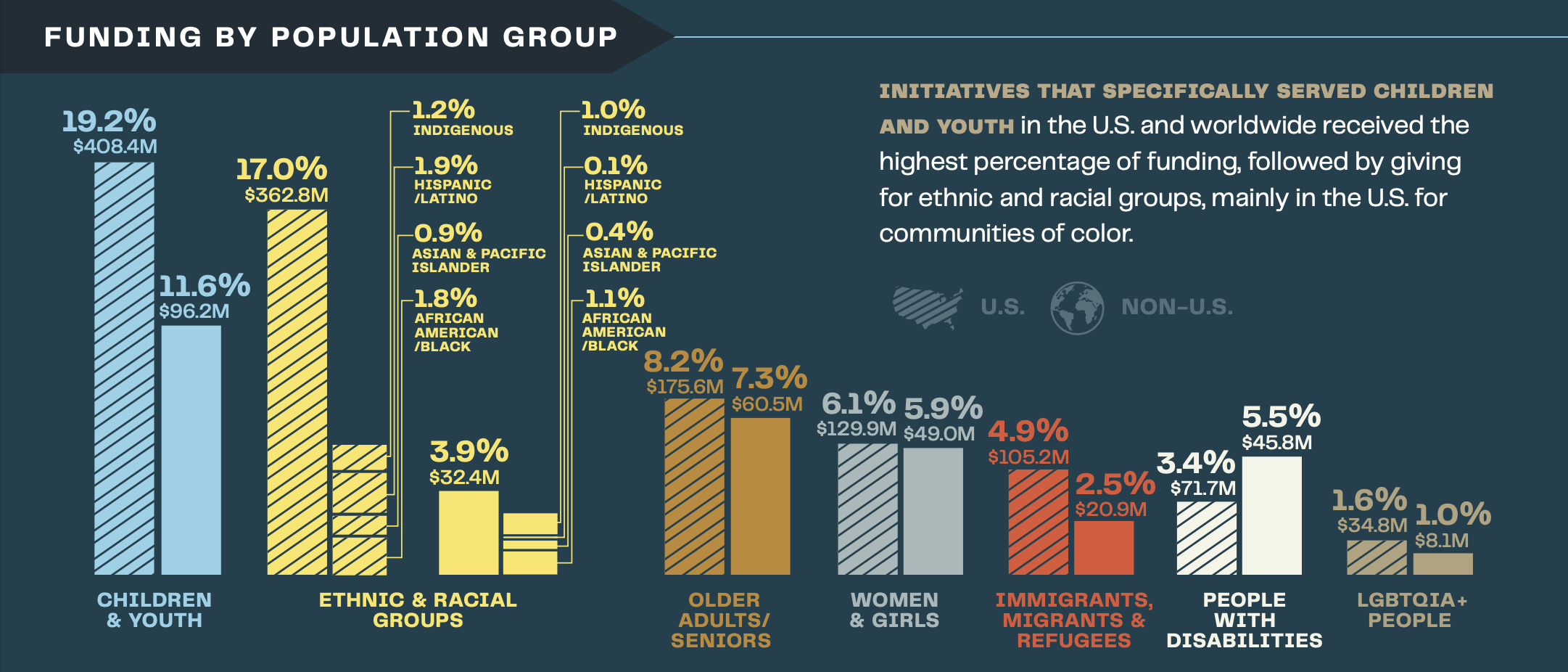New Center for Disaster Philanthropy report finds disaster giving by largest U.S. foundations dipped in 2021
Children and youth, ethnic and racial populations were the top recipients of foundation and corporate philanthropy while COVID-19 spurred grantmaking
Washington, D.C. (Dec. 13, 2023) – As communities worldwide grappled with the impacts of COVID-19 and numerous other devastating disasters, a new report highlights how foundations and corporate donors addressed immense needs in 2021.

The 10th annual Measuring the State of Disaster Philanthropy report by the Center for Disaster Philanthropy (CDP) found that the largest U.S. philanthropic institutions gave less overall in 2021 compared to 2020, which was marked by the extraordinary response to the pandemic.
Overall, efforts that primarily addressed the needs of children and youth and ethnic and racial populations received the highest amount of funding from foundation and corporate donors.
“We are facing a time unlike any other in living memory: The scale, severity and sheer number of disasters threaten to overwhelm communities and those who seek to help them,” said Patricia McIlreavy, president and CEO of CDP. “While our data shows a promising increase in philanthropic generosity, for which we are thankful, it also shows that contributions are not nearly enough, and too often remain focused on immediate need over the long-term recovery support required for a community to thrive post-disaster.”
Key findings

In collaboration with Candid, CDP examined the disaster-related grantmaking in 2021 by private and community foundations, corporations and public charities in the U.S. and abroad.
Data showed that only $3 billion, or 2% of the $157 billion total philanthropic dollars in 2021, was disaster-related. A closer look found that:
- Epidemics, notably the COVID-19 pandemic, were the most-supported disasters, receiving 82%.
- Giving related to natural hazards, such as storms, earthquakes and wildfires, received 6% of funding.
- For every $1 given to disasters, only 10¢ went towards resilience, risk reduction, preparedness, reconstruction and recovery efforts combined.
- In the U.S., efforts that explicitly served children and youth received 19% funding, followed by 17% for ethnic and racial groups.
- Among issue areas that intersect with disasters, health and human services received the most philanthropic funding, followed by education.
- 2021 giving of the Candid’s Foundation 1000 outpaced 2012-2019.

Aside from the pandemic, other notable disasters in 2021 included Hurricane Ida, winter storms and tornado outbreaks in the U.S., Haiti earthquake, Typhoon Rai in the Philippines, and flooding in India, China, Europe and Afghanistan.
View the 2023 Measuring the State of Disaster Philanthropy infographic.
Takeaway for grantmakers
In a blog post, Tanya Gulliver-Garcia, CDP’s director of learning and partnerships, urges grantmakers to:
- Continue to increase overall disaster giving to help meet the immediate and long-term needs of disaster-affected communities. We are witnessing more devastation from humanitarian crises and natural hazards, including those fueled by climate change. For many affected communities, especially for marginalized groups, the road to recovery is long and under-resourced.
- Address the root causes of disparities in their grantmaking. The impacts of the COVID-19 pandemic and other disasters last years and sometimes decades. They exacerbate underlying inequities, such as food and housing insecurity.
- Build relationships with nonprofits responding to disasters before a disaster strikes their community. Preparedness helps reduce the time it takes to rebuild communities after a disaster. This includes strengthening the nonprofit infrastructure to handle the additional stresses a disaster poses.
About the data
Candid is a nonprofit that provides the most comprehensive data and insights about the social sector. CDP used Candid’s data, which included information from funders that reported their grantmaking directly; published media, including English-language news and press releases; and publicly available data sources, including grantmaker websites and IRS Forms 990 and 990-PF. 2021 is the latest available complete calendar year reporting from the IRS.
The data set includes cash grants, grants to individuals, program-related investments, and in-kind gifts with a monetary value from private and community foundations, corporations (including corporate giving programs), and public charities in FY 2021. U.S. and non-U.S. donors are included: Of 3,941 donors, 3,785 are based in the United States, representing 83% of dollars in the data set.
To learn more about the findings and the data used for the 2023 State of Disaster Philanthropy report, please visit disasterphilanthropy.org.
CDP mobilizes philanthropy to strengthen communities’ ability to withstand disasters and recover equitably when they occur. It provides expert advice and educational resources, supports diverse coalitions and manages domestic and international disaster funds on behalf of corporations, foundations and individuals through targeted, holistic and localized grantmaking. Find out more at disasterphilanthropy.org and on X and LinkedIn.